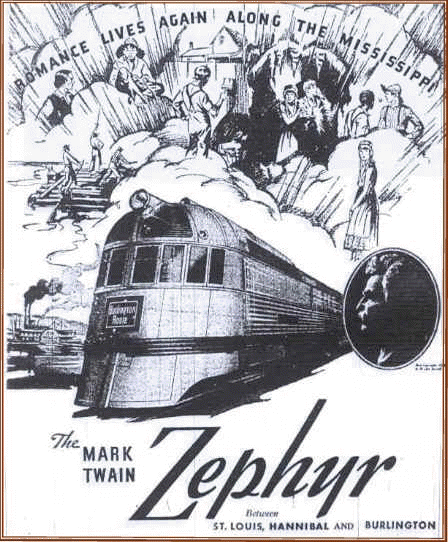 Hannibal, Missouri
---
Hannibal, Missouri
---  Hannibal, Missouri
---
Hannibal, Missouri
---
Mark Twain's boyhood home was an important Mississippi River town. By 1859, Hannibal had over 1000 steamboat landings annually. Hannibal was also soon to become an important railroad town. Judge John Clemens, Twain's father, was one of the original planners of the Hannibal-St. Joseph Railroad. In 1859, with the completion of this railroad, the Mississippi River and Hannibal were linked to the West. Mail would come by steamboat from St. Louis to Hannibal, then travel by railroad to St. Joseph where Pony Express riders would carry it further west. Later, stage coaches took the place of the Pony Express. The first special mail car was built in Hannibal. Mail delivery became even faster because it was sorted while enroute to St. Joseph. The first locomotive built west of the Mississippi, the General Grant, was also built in the Hannibal-St. Joseph yards in Hannibal. Hannibal was attracting national attention. The river, the railroads and the lumber industry were instrumental in an explosive 222% population increase from 1850 to 1860, making Hannibal Missouri's third largest city in 1860. Hannibal became a key city on many railroad routes. In 1882, the Union Depot was built. The depot was jointly owned by the Burlington, Wabash and Katy Railroads. The building was 3 stories with a central skylight. It was also a hotel with 22 rooms on the upper floors. The ornate building had modern plumbing, steam heat and an impressive clock tower with 4 clocks with one facing in each direction.
In the 1910's, 54 passenger trains per day from 6 different railroads came in to the Union Depot. During the 1920's, railroads were affected by nationwide strikes and frequent coal mining strikes. However, passenger service and excursions developed between Hannibal and many points. The Union Pacific offered a round trip to Yellowstone Park for $54.50. The Wabash offered a trip to Niagara Falls for $20.00.
By 1935 Hannibal was also the junction of US Hwy 61 (north and south) and US Hwy 36 (east and west). 1935 was the year of the Mark Twain Centennial Celebration. A year-long program of events was planned to celebrate Twain's 100th birthday. Among the planned events were the construction of a lighthouse, the dedication of the Mark Twain Museum, a nationwide essay contest, a Centennial Pageant-----and the christening of the Mark Twain Zephyr.
The Mark Twain Zephyr was the 4th of the Burlington's Zephyr fleet. On October 23, 1935 during a speed trial the MTZ reached 122 mph and claimed the new world's record for train speed. These diesel-powered stainless steel streamliners held the speed/distance records for many years. These were the forerunners of the diesels that replaced steam locomotives on every railroad after WWII. The MTZ was the first Zephyr to serve St. Louis. Its route would be from Burlington, Iowa to St. Louis and back. The route would follow along the river where Mark Twain had traveled as a steamboat captain. The cars were named for Twain characters.
Hannibal's executive committee for the MTZ Christening included Robert M. Clayton, Dave Griffith, Ben H. Hickman, D.C. Mulvihill, William Pettibone, Henry G. Reidel and I.C. Yates. Eleven communities along the route sent a Tom, Huck and Becky to compete in a contest judged by Nina Gabrilowitsch (Twain's granddaughter). A Chamber of Commerce luncheon at the Mark Twain Hotel for approximately 300 of the distinguished guests would precede the christening. A live CBS radio nationwide broadcast covered the christening. Over 70 stations broadcast the event. Many notables were in attendance. Gov. Park of Missouri, Gov. Herring of Iowa, Ralph Budd (president of the Burlington), former Vice President Dawes, former Secretary of State Kellogg, Senator Harry S. Truman, Senator George D. Clayton, and, of course, Nina Gabrilowitsch were among the nationally known figures. A special platform was built to fit the nose of the engine. The KMOX/CBS microphones were in place. 10,000 people were in attendance. The state champion Quincy High School band opened the program. The train entered the station. The Levee Singers, a group of 100 black vocalists who performed during the Centennial year, sang several songs. At intervals during their songs the Zephyr softly sounded its whistle and was answered by the notes of a steamboat whistle. There were interviews describing the interior of the train, interviews with the winners of the Tom, Huck and Becky contest, and some of the notables spoke. Nina christened the Zephyr with a bottle of American-made champagne (the original plan of Mississippi River water was determined to be bad luck). The christening celebration was a total success. The local newspaper coverage before and during was very thorough.
Public preview excursion rides were offered round trip from Hannibal to West Quincy or Louisiana on Sunday October 27 for 75 cents. The Mark Twain Zephyr began its regular daily service between St. Louis and Burlington on Monday October 28, 1935.
in 1945 Hannibal was once again the host for a celebration for the Mark Twain Zephyr. It's 10th anniversary celebration was in Hannibal on October 25, 1945. Many of the original Christening participants were in attendance. The Chamber of Commerce once again hosted a luncheon in replica of the Christening luncheon.
The Mark Twain Zephyr was retired from service in May 1963. For a few years it was on exhibit at the Midwest Old Thresher grounds in Mt. Pleasant, Iowa. It later moved to Kansas City , then to Joliet. Some attempts have been made at restoration. It continues to reside in the Joliet area and is for sale.
Information from:
The Story of Hannibal by J. Hurley & Roberta Hagood
and
The Hannibal Courier-Post